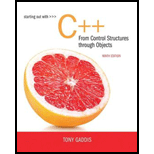
Concept explainers
What is the base case of each of the recursive functions listed in Questions 12, 13, and 14?
Base case:
When the problem is solved without performing recursion is called as a base case.
- In base case, a problem gets solved during its first attempt without getting reiterated to obtain a solution or a problem’s solution could be obtained at the initial stage.
- When a recursive function solves and returns the result without performing any recursive operation is called as Base case of a problem.
Explanation of Solution
Given code:
12.
//include the necessary headers
#include <iostream>
using namespace std ;
//function prototype
int function(int);
//main method
int main()
{
//variable declaration and definition
int x = 10;
//function call to compute the sum
cout << function(x) << endl;
//return the value to be zero
return 0;
}
//function definition
int function(int num)
{
//validates the number is less than or equal to zero
if (num <= 0)
//return the value to be zero
return 0;
else
//call the function recursively
return function(num-1) + num;
}
Explanation:
The above highlighted code is the base case in the given problem, because the value of number is validated to be zero or less than zero, the function will immediately return zero after computing the result.
13.
//include the necessary headers
#include <iostream>
using namespace std;
//function prototype
void function(int);
//main method
int main()
{
//variable declaration
int x = 10 ;
//function call
function(x);
//return the value to be zero
return 0 ;
}
//method definition that displays the given character
void function(int num)
{
//validates the number is greater than zero
if (num > 0)
{
//loop that iterates for the number of times the number that is given
for (int x = 0 ; x < num; x++)
//display the character
cout << '*';
//new line
cout << endl ;
//function call that calls iteratively to display the character in the decremented order
function(num- 1);
}
}
Explanation:
The above highlighted code is the base case for the given code because the code gets executed only when the value of the number that is passed is greater than the zero or else the code will return the zero.
14.
//include the necessary headers
#include <iostream>
#include <string>
using namespace std;
//function protytype that performs the string operations
void function(string, int, int);
//main method
int main()
{
//varible declaration and definition
string mystr = "Hello";
//display the original string
cout << mystr << endl;
//function call that performs string reverse operation
function(mystr , 0 , mystr.size());
//return the value to be zero
return 0;
}
/* function definition that performs the reverse of the string */
void function(string str , int pos, int size)
{
//compares the position of the string with its size
if (pos < size)
{
//function call that performs the string reverse
function(str, pos+ 1, size);
//display the string in reverse order
cout << str[pos];
}
}
Explanation:
The above highlighted code is the base case for the given code, because the function will perform string operation only when the size and position gets validated and if the condition fails, the control will be returned to the called function.
Want to see more full solutions like this?
Chapter 20 Solutions
Starting Out with C++ from Control Structures to Objects Plus MyLab Programming with Pearson eText -- Access Card Package (9th Edition)
Additional Engineering Textbook Solutions
HEAT+MASS TRANSFER:FUND.+APPL.
Computer Science: An Overview (13th Edition) (What's New in Computer Science)
Mechanics of Materials (10th Edition)
Introduction To Programming Using Visual Basic (11th Edition)
Java: An Introduction to Problem Solving and Programming (8th Edition)
INTERNATIONAL EDITION---Engineering Mechanics: Statics, 14th edition (SI unit)
- For this question you will perform two levels of quicksort on an array containing these numbers: 59 41 61 73 43 57 50 13 96 88 42 77 27 95 32 89 In the first blank, enter the array contents after the top level partition. In the second blank, enter the array contents after one more partition of the left-hand subarray resulting from the first partition. In the third blank, enter the array contents after one more partition of the right-hand subarray resulting from the first partition. Print the numbers with a single space between them. Use the algorithm we covered in class, in which the first element of the subarray is the partition value. Question 1 options: Blank # 1 Blank # 2 Blank # 3arrow_forward1. Transform the E-R diagram into a set of relations. Country_of Agent ID Agent H Holds Is_Reponsible_for Consignment Number $ Value May Contain Consignment Transports Container Destination Ф R Goes Off Container Number Size Vessel Voyage Registry Vessel ID Voyage_ID Tonnagearrow_forwardI want to solve 13.2 using matlab please helparrow_forward
- a) Show a possible trace of the OSPF algorithm for computing the routing table in Router 2 forthis network.b) Show the messages used by RIP to compute routing tables.arrow_forwardusing r language to answer question 4 Question 4: Obtain a 95% standard normal bootstrap confidence interval, a 95% basic bootstrap confidence interval, and a percentile confidence interval for the ρb12 in Question 3.arrow_forwardusing r language to answer question 4. Question 4: Obtain a 95% standard normal bootstrap confidence interval, a 95% basic bootstrap confidence interval, and a percentile confidence interval for the ρb12 in Question 3.arrow_forward
 C++ Programming: From Problem Analysis to Program...Computer ScienceISBN:9781337102087Author:D. S. MalikPublisher:Cengage LearningProgramming Logic & Design ComprehensiveComputer ScienceISBN:9781337669405Author:FARRELLPublisher:Cengage
C++ Programming: From Problem Analysis to Program...Computer ScienceISBN:9781337102087Author:D. S. MalikPublisher:Cengage LearningProgramming Logic & Design ComprehensiveComputer ScienceISBN:9781337669405Author:FARRELLPublisher:Cengage Systems ArchitectureComputer ScienceISBN:9781305080195Author:Stephen D. BurdPublisher:Cengage Learning
Systems ArchitectureComputer ScienceISBN:9781305080195Author:Stephen D. BurdPublisher:Cengage Learning C++ for Engineers and ScientistsComputer ScienceISBN:9781133187844Author:Bronson, Gary J.Publisher:Course Technology Ptr
C++ for Engineers and ScientistsComputer ScienceISBN:9781133187844Author:Bronson, Gary J.Publisher:Course Technology Ptr EBK JAVA PROGRAMMINGComputer ScienceISBN:9781337671385Author:FARRELLPublisher:CENGAGE LEARNING - CONSIGNMENT
EBK JAVA PROGRAMMINGComputer ScienceISBN:9781337671385Author:FARRELLPublisher:CENGAGE LEARNING - CONSIGNMENT New Perspectives on HTML5, CSS3, and JavaScriptComputer ScienceISBN:9781305503922Author:Patrick M. CareyPublisher:Cengage Learning
New Perspectives on HTML5, CSS3, and JavaScriptComputer ScienceISBN:9781305503922Author:Patrick M. CareyPublisher:Cengage Learning





